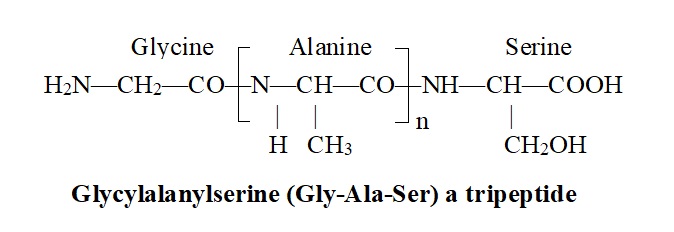Peptides are the compounds formed by the condensation of two or more same or different α-Amino acids. The condensation occurs between amino acids with the elimination of water. Here, carboxyl group of one amino acid and amino group of other amino acid gets condensed with the elimination of water molecule. The resulting ─CO—NH— linkage is called a peptide linkage or peptide bond. The formation of dipeptide and the peptide linkage are discus below:
NH2CH2COOH + CH3 CH (NH2) COOH —→ NH2—CH2—CO—NH—CH(CH3)—COOH + H2O Glycine Alanine Glycylalanine (Gly-Ala)
Polypeptides: If a large number of α-amino acids (hundreds to thousands) are joint by peptide bonds, is called polypeptide as shown below:
 It is clear from the above structure that each polypeptide chain has a free amino (—NH2) group at one end, called amino or N-terminal end and a free carboxylic (—COOH) group at other end, called C-terminal end. The structure is generally written with N-terminal end to the left and C-terminal end to the right. The name of the peptide is written from the names of the amino acids as they appear from left to right starting from N-terminal amino acid. The suffix –ine in the name of the amino acids is replaced by –yl (as glycine to glycyl, alanine to alanyl, etc.) for all amino acids except C-terminal acids.For example, the tripeptide formed by glycine, alanine and serine is written as:
It is clear from the above structure that each polypeptide chain has a free amino (—NH2) group at one end, called amino or N-terminal end and a free carboxylic (—COOH) group at other end, called C-terminal end. The structure is generally written with N-terminal end to the left and C-terminal end to the right. The name of the peptide is written from the names of the amino acids as they appear from left to right starting from N-terminal amino acid. The suffix –ine in the name of the amino acids is replaced by –yl (as glycine to glycyl, alanine to alanyl, etc.) for all amino acids except C-terminal acids.For example, the tripeptide formed by glycine, alanine and serine is written as:
